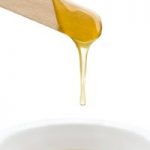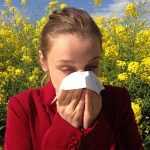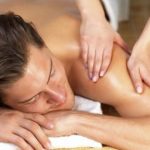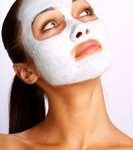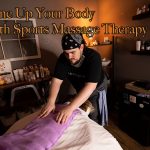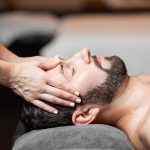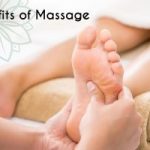When Brendan C., a Chicago-based marathon runner and coach and recovering alcoholic with 20 years of sobriety under his belt, went for a recent massage with his regular therapist, the muscles in his calves and lower back were intractable. His therapist asked him what was going on. Brendan said he had no idea.
The therapist continued working on him. As she did, Brendan began to feel profoundly sad. He realized he was finally feeling the stress fall-out of the recent break-up of a long-time relationship. Only then did his muscles begin to release. “That’s the thing with addicts,” he says, wryly. “We don’t always know what’s going on with us.”
This emotional disassociation can often be a double whammy for those struggling with addictions. “We live in a culture that doesn’t do a good job teaching anyone how to relax, both physically and mentally,” says Jennifer Broadwell, DOM, ADS, an acupuncturist and director of the Wellness Spot, an integrative health center affiliated with the Florida House Experience, a rehab facility based in Deerfield Beach, Florida.
However, this could be changing. More and more, centers such as the Wellness Spot offer a host of non-talk therapies, including massage, as part of their recovery programs. In fact, massage is one of the most popular offerings at the Wellness Spot, with the six therapists doing approximately 200 massages a week.
The center also offers acupuncture, chiropractic services, yoga, meditation and nutritional counseling. Through all of these modalities, but especially massage, “Clients can now feel what it’s like to be present in their own bodies,” says Broadwell.
The Long Road
Recovery is a process, and a difficult one. “Often, the client cannot even articulate what is going on,” Broadwell says. “Because massage is not a talk therapy, it can meet them wherever they are, even if they don’t have the skills to tell us.”
Maureen Schwehr, NMD, a naturopathic physician and craniosacral instructor who works at the integrative clinic at Sierra Tucson, an in-patient rehab facility near Tucson, Arizona, says bodywork offerings are invaluable to the rehab clients, most all of whom choose to participate in them.The massage offerings at Sierra Tucson include Swedish massage, myofascial release, zero balancing, shiatsu, SomatoEmotional Release, and Chi Nei Tsang, a type of Chinese abdomen massage.
Schwehr says that most conventional therapy for recovery focuses on the mind. Once you start considering a mind/body/spirit model, she explains, you have more treatment options. She thinks of the connection this way: “The spirit is who we really are. Our mind is our thinking brain, and our body houses this. If you’re an addict, you often have to ignore your body, because you are, in essence, hurting your ‘house.’” Addicts often continue their destructive behavior by not checking in with their ‘home,’ or their body, she says.
Of course, destructive addictive behavior can have ramifications far beyond the individual addict. According to the National Institute on Drug Abuse (NIDA), addictions impact nearly all American families in some way. Alcohol, nicotine and illegal substances alone cost more than half a trillion dollars a year, in everything from health care costs to crime to accidents to special services in education.
The jury is still out on what causes addiction—most experts say it’s a combination of physiological susceptibility and environment. However, nearly everyone agrees that recovery is not about simple willpower. As one well-known Alcoholics Anonymous aphorism says, “We’re sick people trying to get better, not bad people trying to be good.”
Gabor Mate, M.D., a physician who worked with addicts in the drug-infested Downtown Eastside of Vancouver for years and author of In the Realm of the Hungry Ghost: Close encounters with addiction, says that addiction seems designed to help users escape pain. “All addictions serve as distractions at the very least,” he says.
Nearly any behavior can be addictive—even seemingly benign activities such as shopping, eating and sex. Mate says it really doesn’t matter what the “drug” of choice is—all addictions involve the same brain circuits and brain chemicals. The NIDA says that when addicts get a hit of their drug of choice, dopamine—the feel-good neurotransmitter—floods their brain’s reward system.
This may be why massage, which has been proven to increase dopamine and serotonin, and decrease cortisol, can help those in recovery. Schwehr says this piece is crucial, especially in the early stages of withdrawal when dopamine often drops significantly. “This can be a very uncomfortable time,” she says.
Other physiological and emotional issues in recovery include pain, agitation, anxiety and sleep problems. Massage—nearly any kind of massage—also helps with all of these, says Tiffany Field, Ph.D., director of the University of Miami’s School of Medicine’s Touch Research Institute, which studies massage. “The body releases fewer stress hormones when being massaged,” Field says. Stress hormones, including cortisol, weaken the immune system and can lead to increased pain.“ This becomes, a vicious cycle,” Field says, “one that massage can help break.”
Also, in a study published in 2002, fibromyalgia patients, after receiving massage twice weekly for fi ve weeks, slept and felt better. Levels of neurotransmitter substance P—which your body emits when you are sleep deprived—decreased. “We found a direct relationship,” says Field.
Massage also helps with overall relaxation by stimulating pressure receptors, which enhance vagal activity. Since the vagus nerve is one of the 12 cranial nerves in the brain, this decreases heart rate, lowers blood pressure, and decreases stress hormones, according to Field. “You will sleep better, be less anxious,” says Field. “It’s a whole chemical reaction that is happening.”
Even those who are going through withdrawal from alcohol, cocaine or opiods relaxed more deeply with a simple chair massage than with 20-minute “relaxation sessions,” where participants sat in a quiet room and focused on their breathing. And those who received the massage sustained the relaxation benefits for 24 hours.
On a more superficial level, clients often just feel better after a massage, says Broadwell. “We’re able to show them, ‘This is what relaxation feels like,” she says. “Someone puts healing hands on you, and suddenly you become aware,” Mate says. “Often people say, ‘I never knew I was that sad/happy.’” To this end, massage therapists may have an advantage over medical doctors like him when working with this clientele, says Mate.
“Massage therapists get the stress/disease connection more than doctors do,” he says. “They actually can feel when a client is holding some tension. Physicians don’t put their hands on people like that.”
In Mate’s experience, most of the addicts he worked with—if not all—suffered early life trauma. In fact, he sees childhood trauma and emotional loss as the template for addictions. Many had boundaries violated. Therefore, tread carefully. Ground yourself first. “Make sure what you’re doing is to help them—not to be a hero, or to save anyone,” he says. If a client relapses, he says, and you get angry with them, then you are in a sense violating their boundaries. “Whatever happens to them, don’t take it personally,” Mate adds.
Diane Ansel, a Chicago-based massage therapist, says consider yourself a guide more than anything. “You work on them, and let it go. It’s up to them to turn it around,” she explains.
What you can offer, she says, is simple self-care techniques for between sessions. Ansel says she often takes inspiration in a long-told story of Gandhi. “I love the story of a mother who came to Gandhi and asked him to tell her child not to eat sugar,” she says. “Gandhi said come back next week. When they returned, Gandhi simply told the child, ‘Stop eating sugar.’ When the mother asked, why did they have to go and return for that? He replied, ‘I hadn’t given up sugar yet.’”
Mate says we can’t all wait until we’re perfect in order to help others. “To the extent that you haven’t dealt with your own stuff—or glimpsed your own possibilities—for you can only take people as far as you can go yourself. But no one ever finishes, so you don’t have to wait, just be aware. It takes a lot of self-awareness,” he says.
He also says that, in essence, all addictions are about self-soothing. Therefore, giving them a pathway with which they can connect to their bodies can be enormously empowering. Broadwell sees this with the clients at her wellness center all the time.
The clients start to realize, she says, that the “medicine” is inside of them. “This is a great paradigm shift,” she explains. First, she sees the effects of massage on the faces of the clients. “And then we hear it everyday in patient feedback: That the chronic pain is starting to improve, that they can now sleep with less or no medication,” she adds.
Schwehr says that one of her clients told her that the massage changed her experience at the rehab facility by “100 percent.” Another client told her that the bodywork she had done allowed her to feel connected to her body in a way she had never felt before.
Massage can even help with some basic rewiring of our brains, knowing what we know now about its neuroplasticity. Often, says Mate, early touch experiences of those who struggle with addiction have been “the opposite of healing,” which is partly why he advocates compassionate treatment for addicts rather than tough love. “[With massage therapy,] when they are being touched, it is not to give someone else pleasure, but to put themselves in touch with themselves,” he says. “If there’s some brain circuit that says to be touched is to be hurt,” Mate adds, “imagine being touched not to be hurt, but to be helped.”
Brendan C. experiences this rewiring, one day at a time. Twenty years sober, he says he’s still learning every day how to get in touch with his body and his feelings. Brendan says that many people with addictive personalities do not feel comfortable touching or being touched, himself included. “Part of the reason I drank,” he says, “was to avoid having intimate contact with those around me—my parents, children, wife.”
However, being willing to open up and to trust has made a world of difference. “Massage builds trust. Perhaps for the first time, the body can be completely relaxed, receptive, without the fear that the other person is going to hurt you,” he says.
This is what Schwehr sees all the time at the clinic, she says. “When someone has an opportunity to be touched, to have therapeutic work on their body, it can bring the [recovery] work home to a much deeper level,” she believes. “It can help connect the body to the emotions. I once read that emotions are our body’s way of telling us how it feels about what’s going on. When you bring someone back to their body, it’s like bringing them home.”

